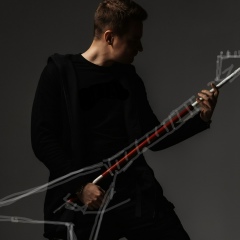В статье про эксперименты в области поведенческой психологии я писал про фактор наблюдения:
«На университетской кухне был кофепоинт с самообслуживанием и списком цен. Кофе стоит доллар, клади доллар в коробку и наливай. Если у тебя 5 долларов, клади 5, бери из коробки сдачу и так далее.
В одни дни над кофепоинтом висела абстрактная картина. В другие — изображение глаза. При сравнимом расходе материалов денег в коробке оказывалось в 3 раза больше в дни с глазом.
Даже напоминания о том, что кто-то может наблюдать, достаточно, чтобы жульничества стало меньше».
Статья: https://vandergrav.ru/behavior-design/
В книге «Мозг материален» Ася Казанцева привела результаты метаанализа 27 подобных экспериментов, в которых участвовали суммарно 19512 человек. Аккуратное обобщение результатов показало, что в присутствии нарисованных глаз люди дают деньги чаще всего на 17% (а не на 200%). Это значение не дотягивает до порога статистической достоверности.
Метаанализ: Artificial surveillance cues do not increase generosity: two meta-analyses — Stefanie B. Northover — Evolution and Human Behavior 38 (2017).
«На университетской кухне был кофепоинт с самообслуживанием и списком цен. Кофе стоит доллар, клади доллар в коробку и наливай. Если у тебя 5 долларов, клади 5, бери из коробки сдачу и так далее.
В одни дни над кофепоинтом висела абстрактная картина. В другие — изображение глаза. При сравнимом расходе материалов денег в коробке оказывалось в 3 раза больше в дни с глазом.
Даже напоминания о том, что кто-то может наблюдать, достаточно, чтобы жульничества стало меньше».
Статья: https://vandergrav.ru/behavior-design/
В книге «Мозг материален» Ася Казанцева привела результаты метаанализа 27 подобных экспериментов, в которых участвовали суммарно 19512 человек. Аккуратное обобщение результатов показало, что в присутствии нарисованных глаз люди дают деньги чаще всего на 17% (а не на 200%). Это значение не дотягивает до порога статистической достоверности.
Метаанализ: Artificial surveillance cues do not increase generosity: two meta-analyses — Stefanie B. Northover — Evolution and Human Behavior 38 (2017).
In an article about experiments in the field of behavioral psychology, I wrote about the observation factor:
“There was a self-service coffee point in the university kitchen with a price list. Coffee costs a dollar, put a dollar in a box and pour it. If you have 5 dollars, put 5, take change from the box and so on.
In some days, an abstract picture hung over the coffee point. In others, an image of the eye. With a comparable consumption of materials, the money in the box turned out to be 3 times more on days with an eye.
Even a reminder that someone can watch is enough to reduce the scam. ”
Article: https://vandergrav.ru/behavior-design/
In the book “The Brain is Material,” Asya Kazantseva presented the results of a meta-analysis of 27 such experiments, in which 19,512 people participated in total. An accurate generalization of the results showed that in the presence of painted eyes, people give money most often by 17% (and not by 200%). This value does not reach the threshold of statistical certainty.
Meta-analysis: Artificial surveillance cues do not increase generosity: two meta-analyses - Stefanie B. Northover - Evolution and Human Behavior 38 (2017).
“There was a self-service coffee point in the university kitchen with a price list. Coffee costs a dollar, put a dollar in a box and pour it. If you have 5 dollars, put 5, take change from the box and so on.
In some days, an abstract picture hung over the coffee point. In others, an image of the eye. With a comparable consumption of materials, the money in the box turned out to be 3 times more on days with an eye.
Even a reminder that someone can watch is enough to reduce the scam. ”
Article: https://vandergrav.ru/behavior-design/
In the book “The Brain is Material,” Asya Kazantseva presented the results of a meta-analysis of 27 such experiments, in which 19,512 people participated in total. An accurate generalization of the results showed that in the presence of painted eyes, people give money most often by 17% (and not by 200%). This value does not reach the threshold of statistical certainty.
Meta-analysis: Artificial surveillance cues do not increase generosity: two meta-analyses - Stefanie B. Northover - Evolution and Human Behavior 38 (2017).
У записи 7 лайков,
4 репостов,
334 просмотров.
4 репостов,
334 просмотров.
Эту запись оставил(а) на своей стене Антон Григорьев


























